#Book PDF
Note
looks around….. do u know where i can reaf wof online
I have the entirety of the wof series as pdfs so you can download them and read them offine too
143 notes
·
View notes
Text
Egypt-China Underworld Book PDF
I recently received an email about this book:
The Netherworld in Ancient Egypt and China: An Imagined Paradise (2023) by Dr. Mu-chou Poo.
It discusses the similarities between the New Kingdom Egyptian and (pre-Buddhist) Western Han Chinese underworlds. I figured it might be of interest to some of my followers, especially since the Chinese underworld appears several times in Journey to the West (1592).
The book is not supposed to be out until December, but I managed to find a PDF online. Click the link to download the PDF.
Here is the book blurb
Considering the striking similarities between the treatment of the dead and conceptions of the netherworld in ancient Egypt and China, how can we compare the two traditions?
Mu-chou Poo considers this question, and provides a new perspective on archaeological materials, including tomb structures and funerary texts, by addressing them in the context of universal human problems such as death, the future of the dead, and the search for happiness in life.
Poo chronologically reconstructs the emergence of the idea of the netherworld and its evolution in both ancient Egypt and ancient China. He explores the relationship between religious beliefs and social ethics in these civilizations, considers why similar social and material conditions could have produced varied expressions of the afterlife, and what such variations reveal about each culture.
Poo argues that a comparison between both visions of the netherworld and their relationship to life experience gives further insight into the nature of each civilization. Through this analysis, Poo shows that thematic comparison of ancient civilizations is not only possible, but also relevant to modern society.
If you liked the digital version, please support the official release.

#journey to the west#JTTW#underworld#hell#Chinese religion#China#Egypt#Egyptian religion#Chinese mythology#Egyptian mythology#Lego Monkie Kid#Ancient China#Ancient Egypt#egyptian art#book pdf
61 notes
·
View notes
Text
RWRB PDF

I've seen a ton of people saying they can't check out the book or find it because its in high demand. So I figured I'd leave this totally very legal copy of the first edition (with bonus special edition chapter) of a totally popular and gay book lying around, in case, you know, anyone needed it.
happy reading yall!
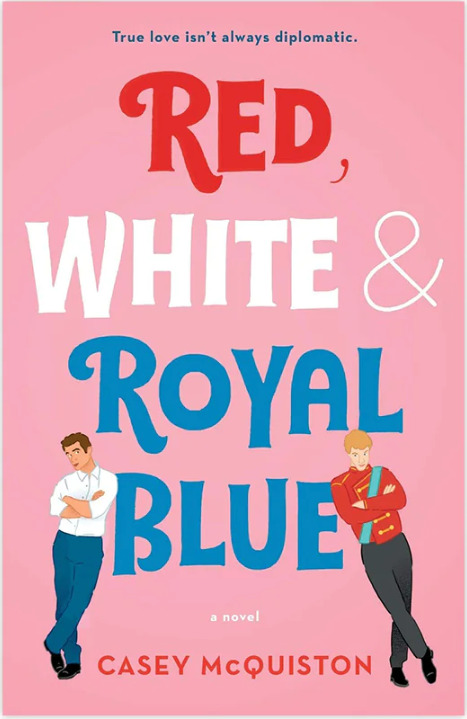
#firstprince#henry fox mountchristen windsor#red white and royal blue#red white & royal blue#henrys chapter#rwrb#alex claremont diaz#book pdf#pdf book#full book pdf#booksbooksbooks#books and reading#book vs movie#book adaptation#rwrb pdf#red white and royal blue pdf#free books#free book pdf#everyone please read this book#read this book#i love him on purpose#history#history huh#histroy huh bet we could make some
134 notes
·
View notes
Text
I FOUND HEROES OF OLYMPUS BOOKS' PDF (1 - 5)
#pjo#percy pjo#percy jackon and the olympians#percy jackson#tv#pjo tv show#annabeth pjo#grover pjo#pdf download#book pdf#holy shit#heroes of olympus#by rick riodan#rick riordan#piper mclean#jason grace#pjo pdf
32 notes
·
View notes
Text

WOLFWALKERS full PDF artbook
8 notes
·
View notes
Text

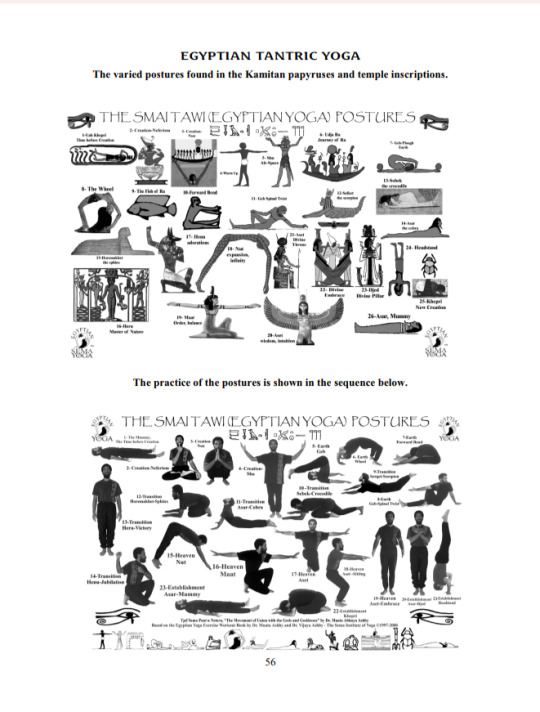
✴️
In celebration of December 29th - 31st Disseminating Moon in Leo/ Rashi, here's the entire book pdf for the Sacred Sexuality of Ancient Egyptian Tantric Yoga.
Enjoy pleasure and lots of wine.
And if you like to do mantras with your meditation/yoga:
ॐ ह्रीं श्रीं सौः |
Om Hreeng Shreeng Sauh
Meaning- Om is regarded as the most spiritual sound in the cosmos. In Hinduism, the sound Om is considered sacred. The Hreem Beej mantra is a tribute to Goddess Bhuvaneshwari. The Shreem Beej mantra is a tribute to Mahalakshmi, the Goddess of gains. The sauh mantra translates to 'I am' and consequently concludes with it.
Benefits of chanting the Simha Rashi mantra:
This Rashi mantra helps in realising our goals and aspirations.
The Simha Rashi mantra gives us the ability to act strong during difficult times.
It helps us have control over our mind and keeps it calm.
This mantra also helps develop better leaders for the future.
Moreover, Simha Rashi mantra helps reduce risks in the field of business.
astrotalk
#tantric yoga#leo moon#astrology#hermeticism#spirituality#book pdf#kemeticism#free knowledge without a shitty price#mantra#vedic astrology#rashi mantra#leo mantra#rashi leo#moon phases#study of the moon#everyday is a celebration#left hand path#right hand path#astrology blog
6 notes
·
View notes
Note
Trick or Treat 🧁
Treat 🎃
A bit of info on Despoina a Goddess in Arcadia, Greece
A third original Arcadian deity, Despoina, the "Mistress," certainly had a pan-Arcadian audience. "There is no deity that the Arcadians venerate more than this Despoina" writes Pausanias (8.37.9). Since we know that the cult at Lykosoura was the only one she received in Arcadia, we must infer that this city's sanctuary was honored by all the Arcadians. When they refused to move to populate Megalopolis, the inhabitants of Lykosoura were forgiven for this by the Arcadians, not only because of the sanctuary's right of asylum, but also because the cult it housed was known to all the Arcadians and its reputation surpassed that of the city of Lykosoura itself.
Furthermore, when he describes the sanctuary, Pausanias does not make reference to the inhabitants of Lykosoura in the way in which he usually records local practices and traditions, but rather just to the "Arcadians." It is the Arcadians who "bring to the sanctuary the produce of their cultivated trees" (8.37.7) and "who celebrate rites of initiation and sacrifice to Despoina" (8.37.8), and "the legend of Anytos is Arcadian" (8.37.6). It should also be noted that the grandeur of the sanctuary's architectural program and the presence in it of a monumental cult-statue group sculpted by Damophon of Messene are out of all proportion to the modest importance of Lykosoura alone. We must accept the probability that Despoina's sanctuary was a pan-Arcadian one.
The deity worshiped, Despoina, was the daughter of Demeter, like Kore, and Eleusinian symbols can be seen in the attributes that the goddess' cult statue held (8.37.4), the torch and the box (kiste), but the goddess' personality was very differ-ent. By her side in the cult group was not just Demeter: Anytos, a strictly Arcadian character, foster-father of Despoina and armed propolos of Demeter, was there too, as was the wild Artemis. The presence of this last goddess, presented as another daughter of Demeter, is to be explained by the affinities she shares with Despoina.
Both goddesses are connected with the animal world. In the Lykosoura cult group Artemis was represented as a huntress. As to Despoina, her relationship with the animal world must have been revealed in the course of the mysteries. A series of votive terracotta figurines found in the Megaron represents standing figures, dressed in cloaks (himatia), the heads of which are those of rams or cows. They carry baskets on their heads. These figurines are usually interpreted as representations of devotees undertaking the role of sacred basket-carrier (kanephoria) in a procession during which they wore animal masks.
— From "The Religious System in Arcadia" in A Companion to Greek Religion (alt link) pp. 267-268
Arcadia on a map, central area of the island of Peloponnese:

-
🖤Trick or Treat🧡
#polytheism#paganism#helpol#hellenic polytheism#arcadia#arkadia#ancient greek religion#greek religion#greece#despoina#goddess#god#deity#resource#source#book pdf#michibooks#quote pile
4 notes
·
View notes
Text
Update for my art and this blog!!!
I'm going to post a LOT less. Sad for me and you, my dear followers. But, alas, I'm 3 weeks into school and my Assaulter (not going into detail) wants to fight me already.
What I will be posting:
Doodles - Mainly from work pages.
A pdf google drive (fully cropped) of Journal 3 because my friend let me borrow the book and I wanted to have a file for it. Sharing it bec I love y'all!!! <3
...That's really it.
But once I start getting the art feels again, I'll rise to my former glory once again!!! Bye friends!
-WeirdGod666
#gay#not art#life update#update#my art#artists on tumblr#doodles#google drive#pdf file#journal 3#book pdf#gravity falls#art update#school#tw assault#< mentioned#i guess??#I don't know how to tag
0 notes
Text
I think, perhaps one of the funniest things to come from EPIC popularising the Odyssey is that now a ton of people think Poseidon wanted to kill Odysseus.
In the Odyssey, Poseidon has no intention of killing Odysseus. In fact, part of the whole reason Zeus lets Poseidon do whatever he wants even though he thinks Odysseus is rad and should get to kiss his wife is explicitly because Poseidon had no intentions of killing Odysseus. Poseidon wanted to pay back the suffering/inconvenience blinding Polyphemus would have caused. It's a really abstract thing tbh. How do you pay back someone permanently disabling your son? Poseidon's solution was just to amputate Odysseus from his other half; i.e. Penelope. The end game was never murder, it was always an endurance race.
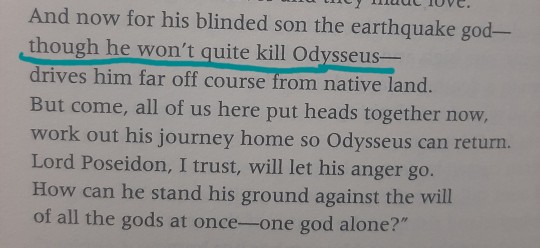
(Od. Book 1: Zeus reassuring Athena that he is not, in fact, a part of Odysseus Hater-Nation. Trans. Robert Fagles)
Also, for those wondering if there's any sort of in text reason for why Poseidon wasn't around in God Games - at the time in the Odyssey when Athena petitions Zeus to let Odysseus leave Calypso's island, Poseidon was -checks notes- on vacation in Ethiopia. Yep. He left to Ethiopia for a festival and thusly was very much absent for Athena's whole "please let Ody go? Please? 🥺" request.
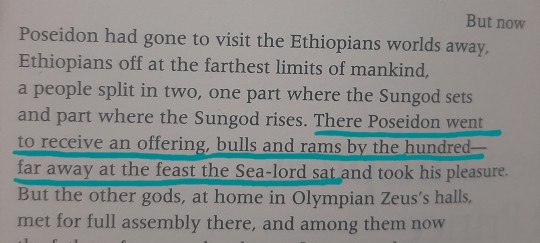
(Od. Book 1: While Odysseus was suffering, Poseidon went to party in the east)
I am begging y'all to read the Odyssey. It's a comedy for everyone except Odysseus and Penelope who are, in fact, suffering 24/7 365.
#ginger rambles#ginger chats about greek myths#Sorry for the quality of the quotes but I'm too tired to google a pdf vers of the Odyssey and then edit those so y'all are getting#my crunchy pictures from one of my physical copies of the book lol#it's reiterated multiple times that Poseidon doesn't want Odysseus dead too#he is literally just driving him mad on the ocean because that's what Odysseus condemned Polyphemus to by blinding him#Also there's no good way to mention this but the Odyssey starts#by Zeus lamenting how mortals blame all their troubles and miseries on the gods when that's just not fair#because the gods go out of their way to warn the mortals that will be saddled with the most wretched fates#and they ignore the gods and do whatever they want anyway LMFAO#It's a really smart way to tie in the whole Orestes plot that would have wrapped up in between Odysseus getting stranded on Ogygia#and Odysseus getting off of Ogygia#epic the musical#epic the wisdom saga#zeus#athena#odysseus#poseidon#the odyssey
3K notes
·
View notes
Text

In this article we’ll tell you Sam by Allegra Goodman Book Review. In “Sam” by Allegra Goodman, the reader is introduced to a captivating exploration of the human experience through the eyes of young Sam READ MORE
0 notes
Text
If you're asking "why are western christians not condemning the bombing of palestinian churches?!" I would highly recommend researching and reading up on the term "Biblical Orientalism"; it's the same reason European and American missionaries have attempted to "convert" the already Christian Arab population.
If you've already figured out that the answer is racism, you'd be right, but I would still recommend reading about biblical orientalism if only to fully understand this specific flavor of racism, how it affects Christian Palestinians, and how it is weaponized in the context of Zionism.
#there's a book by david grafton that covers it but i don't know where to direct you to to get it atm. i'll get back to you!#there's a free paper by lorenzo kamel called 'the impact of biblical orientalism' on academia.edu#if academia.edu is being a pain in the ass to you as it often does dm me and i'll send you a pdf!#in short - no. christian zionists aren't 'hypocrites'. this is perfectly in line with their values. unfortunately.#palestine
6K notes
·
View notes
Text
also in regards to that last article about varied ways of thinking about psychosis/altered states that don't just align with medical model or carceral psychiatry---I always love sharing about Bethel House and their practices of peer support for schizophrenia that are founded on something called tojisha kenkyu, but I don't see it mentioned as often as things like HVN and Soteria House.

ID: [A colorful digital drawing of a group of people having a meeting inside a house while it snows outside.]
"What really set the stage for tōjisha-kenkyū were two social movements started by those with disabilities. In the 1950s, a new disability movement was burgeoning in Japan, but it wasn’t until the 1970s that those with physical disabilities, such as cerebral palsy, began to advocate for themselves more actively as tōjisha. For those in this movement, their disability is visible. They know where their discomfort comes from, why they are discriminated against, and in what ways they need society to change. Their movement had a clear sense of purpose: make society accommodate the needs of people with disabilities. Around the same time, during the 1970s, a second movement was started by those with mental health issues, such as addiction (particularly alcohol misuse) and schizophrenia. Their disabilities are not always visible. People in this second movement may not have always known they had a disability and, even after they identify their problems, they may remain uncertain about the nature of their disability. Unlike those with physical and visible disabilities, this second group of tōjisha were not always sure how to advocate for themselves as members of society. They didn’t know what they wanted and needed from society. This knowing required new kinds of self-knowledge.
As the story goes, tōjisha-kenkyū emerged in the Japanese fishing town of Urakawa in southern Hokkaido in the early 2000s. It began in the 1980s when locals who had been diagnosed with psychiatric disorders created a peer-support group in a run-down church, which was renamed ‘Bethel House’. The establishment of Bethel House (or just Bethel) was also aided by the maverick psychiatrist Toshiaki Kawamura and an innovative social worker named Ikuyoshi Mukaiyachi. From the start, Bethel embodied the experimental spirit that followed the ‘antipsychiatry’ movement in Japan, which proposed ideas for how psychiatry might be done differently, without relying only on diagnostic manuals and experts. But finding new methods was incredibly difficult and, in the early days of Bethel, both staff and members often struggled with a recurring problem: how is it possible to get beyond traditional psychiatric treatments when someone is still being tormented by their disabling symptoms? Tōjisha-kenkyū was born directly out of a desperate search for answers.
In the early 2000s, one of Bethel’s members with schizophrenia was struggling to understand who he was and why he acted the way he did. This struggle had become urgent after he had set his own home on fire in a fit of anger. In the aftermath, he was overwhelmed and desperate. At his wits’ end about how to help, Mukaiyachi asked him if perhaps he wanted to kenkyū (to ‘study’ or ‘research’) himself so he could understand his problems and find a better way to cope with his illness. Apparently, the term ‘kenkyū’ had an immediate appeal, and others at Bethel began to adopt it, too – especially those with serious mental health problems who were constantly urged to think about (and apologise) for who they were and how they behaved. Instead of being passive ‘patients’ who felt they needed to keep their heads down and be ashamed for acting differently, they could now become active ‘researchers’ of their own ailments. Tōjisha-kenkyū allowed these people to deny labels such as ‘victim’, ‘patient’ or ‘minority’, and to reclaim their agency.
Tōjisha-kenkyū is based on a simple idea. Humans have long shared their troubles so that others can empathise and offer wisdom about how to solve problems. Yet the experience of mental illness is often accompanied by an absence of collective sharing and problem-solving. Mental health issues are treated like shameful secrets that must be hidden, remain unspoken, and dealt with in private. This creates confused and lonely people, who can only be ‘saved’ by the top-down knowledge of expert psychiatrists. Tōjisha-kenkyū simply encourages people to ‘study’ their own problems, and to investigate patterns and solutions in the writing and testimonies of fellow tōjisha.
Self-reflection is at the heart of this practice. Tōjisha-kenkyū incorporates various forms of reflection developed in clinical methods, such as social skills training and cognitive behavioural therapy, but the reflections of a tōjisha don’t begin and end at the individual. Instead, self-reflection is always shared, becoming a form of knowledge that can be communally reflected upon and improved. At Bethel House, members found it liberating that they could define themselves as ‘producers’ of a new form of knowledge, just like the doctors and scientists who diagnosed and studied them in hospital wards. The experiential knowledge of Bethel members now forms the basis of an open and shared public domain of collective knowledge about mental health, one distributed through books, newspaper articles, documentaries and social media.
Tōjisha-kenkyū quickly caught on, making Bethel House a site of pilgrimage for those seeking alternatives to traditional psychiatry. Eventually, a café was opened, public lectures and events were held, and even merchandise (including T-shirts depicting members’ hallucinations) was sold to help support the project. Bethel won further fame when their ‘Hallucination and Delusion Grand Prix’ was aired on national television in Japan. At these events, people in Urakawa are invited to listen and laugh alongside Bethel members who share stories of their hallucinations and delusions. Afterwards, the audience votes to decide who should win first prize for the most hilarious or moving account. One previous winner told a story about a failed journey into the mountains to ride a UFO and ‘save the world’ (it failed because other Bethel members convinced him he needed a licence to ride a UFO, which he didn’t have). Another winner told a story about living in a public restroom at a train station for four days to respect the orders of an auditory hallucination. Tōjisha-kenkyū received further interest, in and outside Japan, when the American anthropologist Karen Nakamura wrote A Disability of the Soul: An Ethnography of Schizophrenia and Mental Illness in Contemporary Japan (2013), a detailed and moving account of life at Bethel House. "
-Japan's Radical Alternative to Psychiatric Diagnosis by Satsuki Ayaya and Junko Kitanaka
#personal#psych abolition#mad liberation#psychosis#altered states#antipsych#antipsychiatry#mad pride#peer support#schizophrenia#i have a pdf of the book somewhere if anyone wants#the book and the documentary also discuss some of the pratical struggles in creating a community like this which i also found helpful as#someone who is very interested in helping open a peer respite.
2K notes
·
View notes
Text
Ten Kings of Hell
Those who have read Journey to the West (1592) will know that the Ten Kings of hell appear in chapter three. This is when Monkey's soul is dragged to the underworld, and after causing trouble, he crosses his name out (as well as those of all monkeys) from the ledgers in hell.
Here is a book PDF that discusses the 9th/10th-century scripture that first introduced the Ten Kings.
https://journeytothewestresearch.com/wp-content/uploads/2023/11/Stephen-Teiser-The-Scripture-on-the-Ten-Kings-and-the-Making-of-Purgatory-in-Medieval-Chinese-Buddhism-1994.pdf
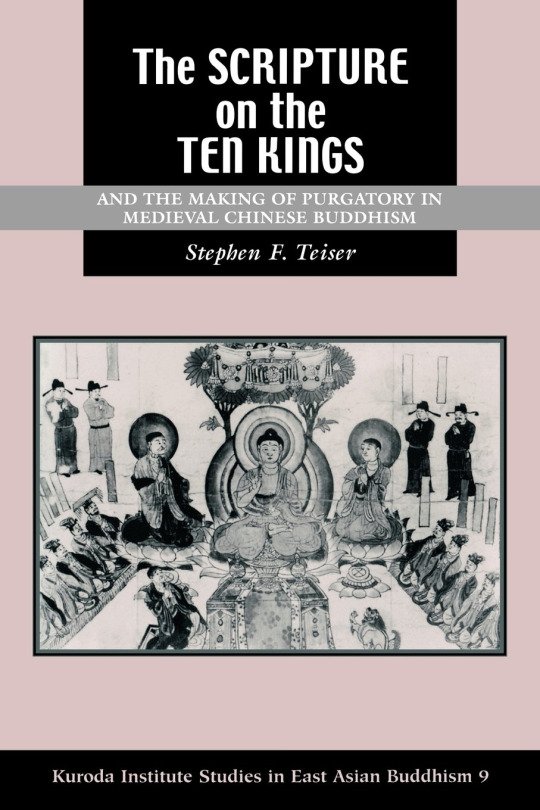
#Ten Kings#Ten Judges#Buddhist hell#purgatory#Buddhism#journey to the west#sun wukong#monkey king#book pdf#hell#underworld#Chinese hell#Chinese underworld#lego monkie kid#LMK#JTTW
57 notes
·
View notes
Link

Heard a few folks were looking to read the Bonus Henry chapters before the movie! I don’t remember who posted the original PDF but I've got the file on here shortly after the collectors edition release. Enjoy.
#red white and royal blue#red white and royal blue bonus chapter#henrys chapter#henry fox mountchristen windsor#alex claremont diaz#rwrb#firstprince#casey mcquinston#rwrb collectors edition#book pdf#bonus chapter pdf#rwrb bonus henry chapter#rwrb henry chapter#i love him on purpose
64 notes
·
View notes
Text
The Religion Called Pragmatism- Chapter One: The Woman's Paradox
Hi Good Fellows and Voracious Readers of Earth!
My next book- The Religion Called Pragmatism, is getting released digitally on my website. Here's chapter one for you. In the unforgettable words of Farhan Qureshi, it's 'Free... Free... FREE.
Best
Rishabh
the-religion-called-pragmatism-ch01Download

View On WordPress
0 notes
